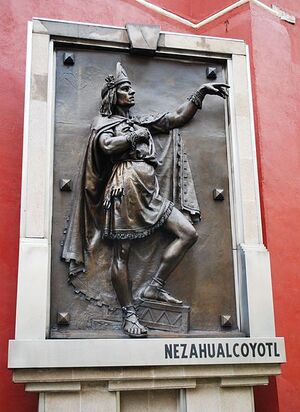Nezahualcoyotl (nonfiction): Difference between revisions
(Created page with "Nezahualcoyotl (Classical Nahuatl: Nezahualcoyōtl, Spanish pronunciation: [nesawaɬˈkojoːtɬ] ( listen), modern Nahuatl pronunciation Listen), meaning "Coyote in fast" or "...") |
No edit summary |
||
| Line 1: | Line 1: | ||
Nezahualcoyotl (Classical Nahuatl: Nezahualcoyōtl, Spanish pronunciation: [nesawaɬˈkojoːtɬ] ( listen), modern Nahuatl pronunciation Listen), meaning "Coyote in fast" or "Coyote who Fasts") (April 28, 1402 – June 4, 1472) was a philosopher, warrior, architect, poet and ruler (tlatoani) of the city-state of Texcoco in pre-Columbian era Mexico. Unlike other high-profile Mexican figures from the century preceding Spanish conquest of the Aztec Empire, Nezahualcoyotl was not Mexica; his people were the Acolhua, another Nahuan people settled in the eastern part of the Valley of Mexico, settling on the eastern side of Lake Texcoco. | [[File:Nezahualcoyotl.jpg|thumb|Bronze casting done of Nezahualcoyotl by Jesús Fructuoso Contreras in the Garden of the Triple Alliance located in the historic center of Mexico City.]]'''Nezahualcoyotl''' (Classical Nahuatl: Nezahualcoyōtl, Spanish pronunciation: [nesawaɬˈkojoːtɬ] ( listen), modern Nahuatl pronunciation Listen), meaning "Coyote in fast" or "Coyote who Fasts") (April 28, 1402 – June 4, 1472) was a philosopher, warrior, architect, poet and ruler (tlatoani) of the city-state of Texcoco in pre-Columbian era Mexico. | ||
Unlike other high-profile Mexican figures from the century preceding Spanish conquest of the Aztec Empire, Nezahualcoyotl was not Mexica; his people were the Acolhua, another Nahuan people settled in the eastern part of the Valley of Mexico, settling on the eastern side of Lake Texcoco. | |||
He is best remembered for his poetry, but according to accounts by his descendants and biographers, Fernando de Alva Cortés Ixtlilxóchitl and Juan Bautista Pomar, he had an experience of an "Unknown, Unknowable Lord of Everywhere" to whom he built an entirely empty temple in which no blood sacrifices of any kind were allowed — not even those of animals. However, he allowed human sacrifices to continue in his other temples. | He is best remembered for his poetry, but according to accounts by his descendants and biographers, Fernando de Alva Cortés Ixtlilxóchitl and Juan Bautista Pomar, he had an experience of an "Unknown, Unknowable Lord of Everywhere" to whom he built an entirely empty temple in which no blood sacrifices of any kind were allowed — not even those of animals. However, he allowed human sacrifices to continue in his other temples. | ||
Latest revision as of 09:35, 7 May 2017
Nezahualcoyotl (Classical Nahuatl: Nezahualcoyōtl, Spanish pronunciation: [nesawaɬˈkojoːtɬ] ( listen), modern Nahuatl pronunciation Listen), meaning "Coyote in fast" or "Coyote who Fasts") (April 28, 1402 – June 4, 1472) was a philosopher, warrior, architect, poet and ruler (tlatoani) of the city-state of Texcoco in pre-Columbian era Mexico.
Unlike other high-profile Mexican figures from the century preceding Spanish conquest of the Aztec Empire, Nezahualcoyotl was not Mexica; his people were the Acolhua, another Nahuan people settled in the eastern part of the Valley of Mexico, settling on the eastern side of Lake Texcoco.
He is best remembered for his poetry, but according to accounts by his descendants and biographers, Fernando de Alva Cortés Ixtlilxóchitl and Juan Bautista Pomar, he had an experience of an "Unknown, Unknowable Lord of Everywhere" to whom he built an entirely empty temple in which no blood sacrifices of any kind were allowed — not even those of animals. However, he allowed human sacrifices to continue in his other temples.
In the News
Fiction cross-reference
Nonfiction cross-reference
External links:
- Nezahualcoyotl @ Wikipedia
